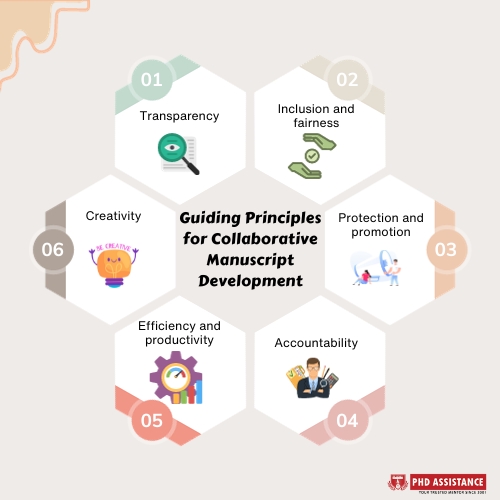Guiding Principles and Strategies for Effective Collaborative Manuscript Development
The authors present approaches for effective collaborative manuscript development in large, interdisciplinary teams based on six guiding principles: creating a transparent, inclusive, and accountable research team, fostering creativity and productivity, understanding team composition, creating an authorship policy, openly announcing manuscript editing ideas, identifying manuscript type, leading author management style, and documenting authorship contributions. These approaches reduce group conflict, uphold team values, achieve fair authorship practices, and increase science productivity.

Introduction
Science is increasingly conducted in collaborative writing and often interdisciplinary team settings to solve our time’s large-scale and complex problems. Publishing research articles in peer-reviewed journals is the primary mechanism by which these research teams disseminate findings to the broader scientific community and the primary currency for promoting and recognizing individuals. Publishing with science teams has distinct benefits for both the researcher and science; collaborative manuscripts are more likely to be accepted in scientific journals and have higher citation rates once published, presumably reflecting higher quality and impact.
- Check out our sample PhD Manuscript to see how Manuscript Development is structured.
Effective collaborative manuscript development process requires a well-organized and cooperative approach among authors. Whether you’re working on a research paper, a book, or a written document with multiple contributors. Here are some guiding principles and strategies to ensure a smooth and productive process: 1) Clear Communication,2) Outline and Structure, 3) Deadlines and Milestones, 4) Version Control, 5) Consistent Style and Formatting, 6) Peer Review, 7) Editing and Proofreading, 8) Acknowledgments, 9) Submission and Review
Guiding Principles
The guiding principles for collaborative manuscript development are to create a transparent, inclusive, and accountable research team that promotes creativity and productivity while protecting less influential members. Balancing these principles is challenging, as striving for one can sometimes compromise others. These principles are essential in research and can be applied to many research teams.
- Transparency
Transparency in development manuscript submission involves clearly documenting ideas, decisions, and actions throughout the types of manuscript lifespan, from idea inception to publication. This prevents misunderstandings and conflicts, records individual contributions, and aligns with open science goals to make research design publicly accessible and reproducible.
- Inclusion and fairness
Inclusivity and fairness are crucial in large collaborative writing examples with diverse backgrounds and disciplines. This promotes innovation and creativity, leading to high-impact science. Strategies for promoting inclusion include enhancing interpersonal skills and social sensitivity through teamwork exercises rather than individual manuscripts in research.
- Protection and promotion
The goal is to protect, promote, and empower underrepresented members of research teams, such as students, early-career scientists, and minorities. To ensure fair practices, power differentials are considered in scientific collaborations. Alternate team structures, such as flat-structured ones, can reduce power differences and abuse.
- Accountability
The principle of coauthorship requires authors to be accountable for their work, but some manuscript publishing, like multidisciplinary ones, requires different accountability distributions among team members. Strategies to facilitate accountability include drafting author contribution statements, transparency, and discussions on contributorship vs. accountability.
- Efficiency and productivity
The goal is to promote efficient manuscript development in large strategies for effective collaborative writing topic selection, avoiding ineffective dynamics and debates. Practical facilitation, communication, and leadership strategies can help avoid these issues and make collaborative efforts efficient, productive, and creative. This ensures the timely creation and dissemination of research products and incentivizes team science scientists.
- Creativity
Collaborative research should prioritize individual and group creativity to maximize novel and innovative science. However, discussions on fostering creativity are lacking in science, and strategies for group creativity may be overlooked. High-impact publications often result from connections across disciplines. Strategies should include individual reflection and team brainstorming.

Strategies for Effective Collaborative Manuscript Development
The following strategies for manuscript development are grounded in the above guiding principles and involve practices that apply to all individual manuscript writing being developed by any research team member. After a research team has discussed and documented their guiding principles, they can implement team- and manuscript-level practices designed to uphold and balance the guiding principles.
(1) describe and understand their team composition and
(2) create a team coauthorship policy. Team members then apply the remaining strategies for each manuscript, including
(3) announce manuscript ideas and solicit coauthors,
(4) identify and communicate the manuscript type,
(5) identify and communicate the authorship management strategy and
(6) determine authorship contribution and order.
By adhering to these guiding principles and strategies, you can enhance the effectiveness of collaborative manuscript development and increase the likelihood of producing a high-quality publication. Collaboration, communication, and organization are key to success in this endeavour.
- Check out our study guide to learn how to develop a thesis into a manuscript paper.
Conclusion
In conclusion, effective collaborative manuscript development is a multifaceted process that hinges on clear communication, meticulous planning, and a commitment to shared goals. Authors must navigate through a structured theoretical framework, maintain open dialogue, and adhere to established guidelines to ensure a harmonious and productive collaboration. Authors can surmount the challenges of working together seamlessly by prioritizing deadlines, transparent peer review, ethical standards, and consistency in style and formatting. Embracing these principles and strategies ensures that collaborative writing for student’s journey leads to a rewarding destination in academic and professional writing.
About PhD Assistance
At PhD assistance, our Ph. D experts offer end-to-end services where our experts help to rewrite your manuscript (translate your ideas) based on your ideas and suggestions, involve in statistics and programming, followed by editing and proofreading, formatting as per the journal style and finally to the submission. Our expert and experienced team members are well-versed in various research domains and have successfully handled these challenges many times during the development of dissertations to numerous PhD students.
References
- Oliver, Samantha K., et al. “Strategies for effective collaborative manuscript development in interdisciplinary science teams.” Ecosphere4 (2018): e02206.
- Moshontz, Hannah, et al. “A guide for many authors: Writing manuscripts in large collaborations.” Social and Personality Psychology Compass4 (2021): e12590.
- Cheruvelil, Kendra S., et al. “Creating and maintaining high‐performing collaborative research teams: the importance of diversity and interpersonal skills.” Frontiers in Ecology and the Environment1 (2014): 31-38.
 Previous Post
Previous Post
